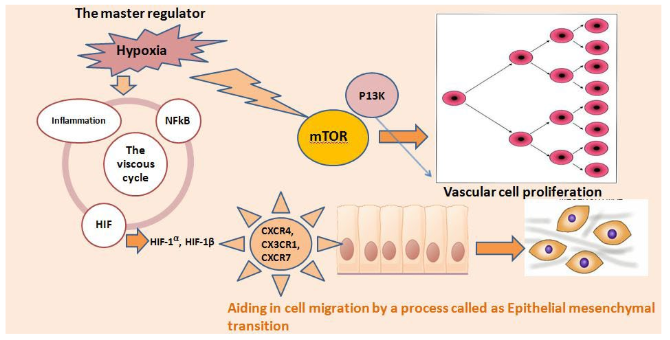1. Dekker E, Gulik TV. Colorectal cancer: What the clinician wants to know. Cancer Imaging. 2005; 5: S127-S132. doi: 10.1102/1470-7330.2005.0036
2. Triantafillidis JK, Nasioulas G, Kosmidis PA. Colorectal cancer and inflammatory bowel disease: Epidemiology, risk factors, mechanisms of carcinogenesis and prevention strategies. Anticancer Res. 2009; 29: 2727-2738. Web site. http://ar.iiarjournals.org/content/29/7/2727.long. Accessed July 3, 2016
3. Clevers H. Colon cancer-understanding how NSAIDs work. N Engl J Med. 2006; 354: 761-763. doi: 10.1056/NEJMcibr055457
4. Schottelius AJ, Dinter H. Cytokines, NF-ÎB, microenvironment, intestinal inflammation and cancer. Cancer Treat Res. 2006; 130: 67-87. doi: 10.1007/0-387-26283-0_3
5. Yan B, Wang H, Rabbani ZN, et al. Tumor necrosis factor-alpha is a potent endogenous mutagen that promotes cellular transformation. Cancer Res. 2006; 66(24): 11565-11570. doi: 10.1158/0008-5472.CAN-06-2540
6. Müller-Edenborn K, Léger K, Garzon JFG, et al. Hypoxia attenuates the proinflammatory response in colon cancer cells by regulating IκB. Oncotarget. 2015; 6(24): 20288-20301. doi: 10.18632/oncotarget.3961
7. Hongo K, Nelson Tsuno H, Kawai K. Hypoxia enhances colon cancer migration and invasion through promotion of epithelial-mesenchymal transition. J Surg Res. 2013; 182: 75-84. doi: 10.1016/j.jss.2012.08.034
8. Luo X, Jinke Yao H, Nie P. FOXM1 promotes invasion and migration of colorectal cancer cells partially dependent on HSPA5 transactivation. Oncotarget. 2016; 7(18): 26480-26495. doi: 10.18632/oncotarget.8419
9. Ghadjar P, Rubie C, Aebersold DM, et al. The chemokine CCL20 and its receptor CCR6 in human malignancy with focus on colorectal cancer. Int J Cancer. 2009; 125(4): 741-745. doi: 10.1002/ijc.24468
10. Gunther K, Leier J, Henning G, et al. Prediction of lymph node metastasis in colorectal carcinoma by expression of chemokine receptor CCR7. Int J Cancer. 2005; 116: 726-733. doi: 10.1002/ijc.21123
11. Kapur N, Mir H, Clark Iii CE, et al. CCR6 expression in colon cancer is associated with advanced disease and supports epithelial-to-mesenchymal transition. Br J Cancer. 2016; 114(12): 1343-1351. doi: 10.1038/bjc.2016.113
12. Rubie C, Oliveira V, Kempf K, et al. Involvement of chemokine receptor CCR6 in colorectal cancer metastasis. Tumor Biol. 2006; 27: 166-174. doi: 10.1159/000092777
13. Kawada K, Hosogi H, Sonoshita M. Chemokine receptor CXCR3 promotes colon cancer metastasis to lymph nodes. Oncogene. 2007; 26(32): 4679-4688. doi: 10.1038/sj.onc.1210267
14. Francipane MG, Lagasse E. mTOR pathway in colorectal cancer: An update. Oncotarget. 2013; 5(1): 49-66. doi: 10.18632/oncotarget.1548
15. Roulin D, Cerantola Y, Dormond-Meuwly A, Demartines N, Dormond O. Targeting mTORC2 inhibits colon cancer cell proliferation in vitro and tumor formation in vivo. Mol Cancer. 2010; 9: 57. doi: 10.1186/1476-4598-9-57
16. Gulhati P, Cai Q, Li J, et al. Targeted inhibition of mammalian target of rapamycin signaling inhibits tumorigenesis of colorectal cancer. Clin Cancer Res. 2009; 15(23): 7207-7216. doi: 10.1158/1078-0432.CCR-09-1249
17. Gulhati P, Bowen KA, Liu J, et al. mTORC1 and mTORC2 regulate EMT, motility, and metastasis of colorectal cancer via RhoA and Rac1 signaling pathways. Cancer Res. 2011; 71(9): 3246-3256. doi: 10.1158/0008-5472.CAN-10-4058
18. Mukherjee B, Tomimatsu N, Amancherla K, et al. The dual PI3K/mTOR inhibitor NVP-BEZ235 is a potent inhibitor of ATM- and DNA-PKCs-mediated DNA damage responses. Neoplasia. 2012; 14(1): 34-43. doi: 10.1593/neo.111512
19. Allen IC, TeKippe EM, Woodford RM, et al. The NLRP3 inflammasome functions as a negative regulator of tumorigenesis during colitis-associated cancer. J Exp Med. 2010; 207(5): 1045-1056. doi: 10.1084/jem.20100050
20. Zaki MH, Boyd KL, Vogel P, Kastan MB, Lamkanfi M, Kanneganti TD. The NLRP3 inflammasome protects against loss of epithelial integrity and mortality during experimental colitis. Immunity. 2010; 32(3): 379-391. doi: 10.1016/j.immuni.2010.03.003
21. Zaki MH, Lamkanfi M, Kanneganti T-D. The Nlrp3 inflammasome in IBD and colorectal tumorigenesis. Trends Immunol. 2011; 32(4): 171-179. doi: 10.1016/j.it.2011.02.002
22. Dupaul-Chicoine J, Arabzadeh A, Dagenais M, et al. The Nlrp3 inflammasome suppresses colorectal cancer metastatic growth in the liver by promoting natural killer cell tumoricidal activity. Immunity. 2015; 43(4): 751-763. doi: 10.1016/j.immuni.2015.08.013
23. Tiwari K, Pandey SK, Goel S. SPINK1 promotes colorectal cancer progression by downregulating Metallothioneins expression. Oncogenesis. 2015; 4: e162. doi: 10.1038/oncsis.2015.23
24. Chen Y-T, Tsao S-C, Shyng-Shiouvyuan F. Serine protease inhibitor kazal type 1 (SPINK1) promotes proliferation of colorectal cancer through the epidermal growth factor as a prognostic marker. Pathol Oncol Res. 2015; 21: 1201-1208. doi: 10.1007/s12253-015-9949-0
25. Chen Y-T, Tsao S-C, Tsai H-P. Serine protease inhibitor kazal type 1 (SPINK1) as a prognostic marker in stage IV colon cancer patients receiving cetuximab based targeted therapy. J Clin Pathol. 2016; 1-5. doi: 10.1136/jclinpath-2016-203638
26. Sinicrope FA, Gill S. Role of cyclooxygenase-2 in colorectal cancer. Cancer Metastasis Rev. 2004; 23: 63-75. doi: 10.1023/A:1025863029529
27. Wang D, Raymond Dubois N. The role of COX-2 in intestinal inflammation and colorectal cancer. Oncogene. 2011; 29(6): 781-788. doi: 10.1038/onc.2009.421
28. Li M, Wu X, Xu X-C. Induction of apoptosis in colon cancer cells by cyclooxygenase-2 inhibitor NS398 through a cytochrome c-dependent pathway. Clin Cancer Res. 2001; 7: 1010-1016. Web site. http://clincancerres.aacrjournals.org/content/7/4/1010.long. Accessed July 3, 2016
29. Sheehan KM, Sheahan K, O’Donoghue DP, et al. The relationship between cyclooxygenase-2 expression and colorectal cancer. JAMA. 1999; 282(13): 1254-1257. doi: 10.1001/jama.282.13.1254
30. Sun Y, Tang XM, Half E, Kuo MT, Sinicrope FA. Cyclooxygenase-2 overexpression reduces apoptotic susceptibility by inhibiting the cytochrome c-dependent apoptotic pathway in human colon cancer cells. Cancer Res. 2002; 62(21): 6323-6328. Web site. http://cancerres.aacrjournals.org/content/62/21/6323.full-text.pdf. Accessed July 3, 2016
31. Tang X, Sun YJ, Half E, Kuo MT, Sinicrope F. Cyclooxygenase-2 overexpression inhibits death receptor 5 expression and confers resistance to tumor necrosis factor-related apoptosis- inducing ligand-induced apoptosis in human colon cancer cells. Cancer Res. 2002; 62(17): 4903-4908. Web site. http://cancerres.aacrjournals.org/content/62/17/4903.full-text.pdf. Accessed July 3, 2016.






